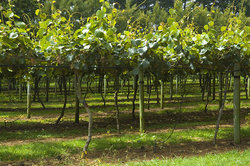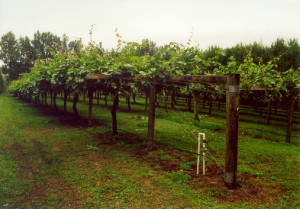Kiwi Growing
Kiwi growing is actually a very fun and engaging activity you can do by yourself or with your family, especially your kids, all year round. However, like any other kind of vegetation, kiwis and their vineyards require proper care for them to bear a lot of fruits and flowers.
For starters, you can keep in mind these tips:
Best Climate for Kiwis
There are different types of kiwis all over the world, and some are even grown in California as well as China. Thus, the fruits have the ability to survive in varying temperatures. However, you will produce the greatest yield if you can match the fruit variant to the season. For example, the hardy kiwis survive in New Zealand, where there’s enough shade even during hot climates.Ideal soil for Kiwi Farming
Kiwis need sandy loam, though they struggle in clay. They have to be not only moist and deep but also well drained. It’s highly recommended that you water the newly transplanted vines regularly, but once you can see them taking hold, you can then slow down a bit. Watering also ensures the soil remains moist. If your area experiences harsh summer at time, it’s best if there’s an excellent irrigation system in place. Smaller vineyards can also benefit from them.
Wind is one of the greatest enemies in kiwi growing. The flowers and leaves of the plant are very fragile, and they can easily give in to very strong winds. In regions where winds are strong, installing windbreakers may be able to solve the problem.
Farmers should also watch out for light frosts, as they can give undue damage to the leaves of kiwis. When applying fertilizers, a small amount should be used during the early parts of summer or spring to avoid burning.
Recommended Layout for Kiwi Vines
Ideally, you need an ample space for kiwi growing. In fact, some kiwis can grow as high as 10 to 30 feet. Male and female vines should be spaced between 10 and 18 feet. Today, though, it’s common among homes to have kiwis in their gardens. To do this, you can use a T-bar trellis. Fashioning them into an arbour or letting the vineyards grow on pergolas is perfect for aesthetic reasons.
Kiwi Growing and Pollination
Since kiwis don’t produce fruits and flowers on their own, they have to depend on pollination, particularly with the help of insects. Thus, you should never forget to plant both male and female vines.
Pruning Kiwis
Kiwi growing should include planning for pruning. This ensures that the plant is well taken care of and produces abundant flowers and fruits. Your plan, however, depends on the climate. If you’re living in a cooler region, a lot of pruning for males should be performed during the summer. In warmer areas, hold yourself from pruning during fall and spring since too much sunlight from burn the plant.
Harvesting the Fruits
Kiwi growing plans include harvesting. Before harvesting a lot, obtain a few and allow them to become soft. That would take a few days. When they taste sweet, you can harvest the rest and place inside a cooler area, such as refrigerator.
Choosing a site for Kiwifruit Cultivation
The best site to plant a kiwi fruit tree is in a moderately sunny place, where they can
ramble across a trellising system. They will tolerate a light shade, if needed. Vines
should be protected from strong winds, since they can snap off new growth
The soil should be acidic, with a pH of about 5-6.5, rich in organic matter and not
too salty. If the soil is too basic, leaves will show nitrogen deficiency
Water is fundamental to kiwifruit plants: they should be planted on a well drained
soil and watered constantly, especially in summer when they usually undergo the most
stress. Water is the single most important cause of kiwifruit tree exfoliation: leaves
will usually turn brown and fall off if the plant has to endure constant stress
Kiwifruit trees need a lot of nitrogen, especially in the early season, so add a
nitrogen-rich fertilizer early on. Adding nitrogen in late season may cause the fruit to
store poorly, so it’s a best practice to avoid overdoing it. Early fertilizations can be
done with an avocado tree fertilizer, while watering well, around March. Subsequent
fertilization can be done in early summer.
Mulching is also recommended, using manure or straw, even though the mulch should not
come in direct contact with the vine
Pruning is very important for adequate fruiting: since the vine usually grows on a
wire or t-bar system, it should be pruned where it forms a “pigtail” shape, at the end of
the growth spurt.
How to plant a Kiwi Fruit Vine
You can purchase a kiwi fruit seeds in a store, and plant them in spring, in a moist
planted (but not soaking with water). In about 5 weeks, the seeds will germinate: at that
point they will need grafting to allow for better plants and to produce known sex
plants.
If you intend to purchase a grown plant, it is slightly better to choose the cutting
grown (the other choice being a grafted plant), since it usually withstands winter
freezes better.
Pests and diseases are not a big problem to kiwifruit plants, since the soil they grow
on is not usually home to pests. However, the plant attracts animals like cats (that love
to rub against new shoots, damaging them), deer, garden snails and gophers. Be wary of
root-rot nematodes that may weaken the plant, especially in its young stage
Kiwi fruit should be harvested around mid-november, when the seeds are completely
black. It can then be stored in a plastic bag, inside a refrigerator, where it can last
up to several months. It can also be further ripened if kept in a plastic bag, at ambient
temperature


